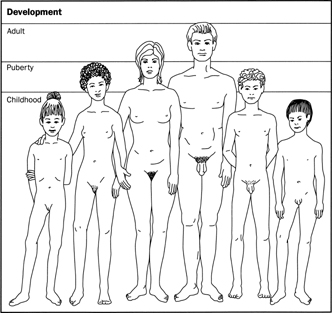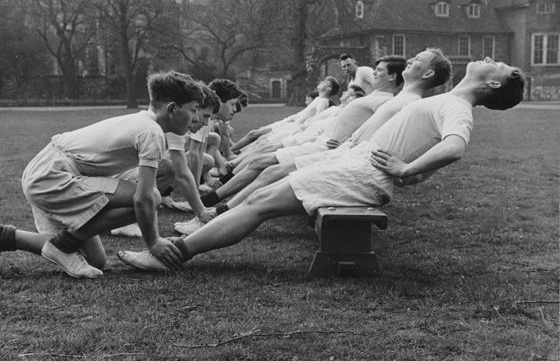Children’s Health: Less Healthy Than 50 Years Ago
Your grandparents and great-grandparents are always the shortest ones in all your family photos, right? It’s the same with all of us.
Your kids are taller, better fed and wealthier than your grandparents; so, why are today’s children LESS healthy than 50 years ago? Children’s health has actually gotten worse!
Children today are less healthy than 50 years ago
Yea, I said “less.” An article from Great Britain I read a couple years ago made it into my “possibles file” and over the intervening years other research pieces got added slowly to the pile; until, today, they’re finally going to see fresh air by helping to assert a very unexpected observation: Children today are less healthy than they were 50 years ago.
Children Less Healthy
Comparing 11 year-olds with those in 1961
Let’s see if that can be true—and in what way.
First, let’s define that being healthy and “health” overall is a lot more than merely not dying of a disease. Cholera, diptheria, measles, tuberculosis, leprosy, thyphoid—we don’t deal much with those any more; but, frankly, have replaced them with a lot of other things.
Being “healthy” implies some kind of “living with vigor and productivity” doesn’t it?
I don’t believe you’d even dare try to argue with me when I say that over the past 50 or so years children have gotten more obese (there I said it, not just “heavier.”) What you may not know is that several other not-so-good things have happened too.
Here, grab a seat and let’s chat a spell. Let’s talk about eleven-year-old children today as compared with those in 1961.
First The Background: Puberty, Height and Weight

Height, weight and puberty are linked in many ways that are still enigmatic. They’re like three little kids bouncing on their parent’s bed.
We know that loosing weight due to heavy exercise will often delay the onset of menstruation in girls—but really not a clue why.
We know that slight malnutrition brings down weight of course, but height has his “buddy’s” back and slows down too. Some medicines decrease weight and have the same effect on height.
And even their “buddy” puberty gets into the act and delays itself a bit. We don’t really know how they do it, but they do.
It works the other way too. Overfeeding an infant no only balloons them across the weight lines on the growth chart but height pushes ahead too; and, unless some other factor intervenes, puberty usually sprouts early.
That often leaves physicians and researchers scratching their heads with “chicken and egg” questions. Which came first? Which is causing which? And, where is the “sweet spot” of “normal?”
With that in mind, let’s talk growth statistics.
HEIGHT

NOW: 4ft 7in
The average British child (why would US children be any different) has increased between 1cm and 3cm (0.3-1.1 inches) every 10 years for the past 50 years. They are between 5cm and 15cm (2-6 inches) taller today.
Is this a good thing? What is the “sweet spot” for height? You know, the healthy height in order to get things done but not living with constant back pain from the increased height?
People are giving credit to improved nutrition, especially in pregnancy, along with a better intake of vitamins and minerals. But, keep in mind the relationship with weight we described above. How much is too much?
And, it’s also possible that the decrease in women smoking during pregnancy might also have played a role by preventing its stunting of intrauterine growth.
Of course it matters that children (and adults) have “better” nutrition and that mothers have learned they shouldn’t smoke during pregnancy. But, that is also beginning to be counter-balanced with an increase in the number of people with back pain—and back pain which is starting at a younger age.
WEIGHT

NOW: Boy 88lb; Girl 97lb
If a body gets taller, one would expect the weight to be greater too; if for no other reason than there’s more to measure. More muscle mass, bone, skin you get the picture.
That’s the definition of the Body Mass Index (BMI), the relationship of weight divided by height-squared taking into consideration conversion factors. If the height goes up in proportion to the weight the BMI stays the same—it changes when they do not.
And, from what we’ve already said, the BMI may not be the best indicator of children’s health because of the interrelationships—if the weight goes up excessively, it will “push” the height up too but in the BMI equation the height is squared. It sounds complicated but basically the equation used sort of “under-reports” obesity.
BUT, being healthy isn’t just height and weight there’s nutrition too. Other research hints that children are eating a bit less now than 50 years ago; but what they do eat is more fat and sugar AND they’re doing a whole lot less work to make them hungry. Everyone is doing less than they used to!
In 1966, the average BMI for an eight-year-old boy was 16.55. In 2007, it was 17.18; and remember, very small changes make a great difference in this measurement.
What we’ve noticed is that: children from families who have tended to be overweight in the past have become more overweight or obese, children from poorer areas are more likely to have a change in BMI and malnourishment has risen in all children—both skinny and obsese).
So What? Carrying excess visceral fat (around stomach) triggers Type 2 diabetes and children as young as 12 now are being diagnosed with what used to be only an adult disease.
Thousands of children have undiagnosed “metabolic syndrome” – a precursor for chronic diseases such as diabetes, heart and vascular diseases – almost unheard of in children until the past decade.
High blood pressure, elevated cholesterol—in children!
PUBERTY (year onset)

NOW: Boy 13½; Girl 11
Most kids know that voice breaking and the first period means you’re in puberty (for boys and girls respectively).
Thing is though, that age didn’t change at all clear from the ’40s to almost the ’80s; but then, especially in girls from poorer backgrounds, the age of first menses dropped suddenly.
Greater body weight was first to be blamed and was also causing a lower age for puberty in boys too.
In the past 10-15 years however, the onset of puberty has dropped even more rapidly (up to a full year) according to Danish researchers and they offer that unhealthy lifestyles and exposure to chemicals in food should be pulled into the mix.
Children from broken homes experience puberty earlier some studies have found; so, stress has its head in the scrum too—perhaps from its altering of the body’s chemical balance.
Whatever the reason, it’s estimated that at least one in six children under the age of ten is experiencing puberty these days.
Why should we care? Well, a whole lot of studies have shown that boys experiencing early puberty were more likely to display aggressive behavior and earlier puberty is one of the factors which influences a girls risk of developing breast cancer.
The study in Britain references that breast cancer has risen by 50 percent in the past 25 years including the number affected before menopause. The study about boy’s aggression was done in the U.S..
TEETH (decay, missing, filled)

NOW: 1.5 (12 yo)
For the most part children’s teeth have gotten quite a bit better in the past 50 years and it’s mostly due to fluoride in the toothpaste which re-mineralizes tooth enamel making it harder and most resistant.
The study I’m referencing claims that British 12-year-olds have the best dental health in all of Europe; however, for younger children… not so much. About a third of 5-year-olds have dental decay, totally preventable—disappointing!
One thing I didn’t realize until now is that it takes over an hour for your saliva to neutralize the acid from food and drink in your mouth; which means, if you “graze” like people do these days the teeth never can recover—hence more cavities.
Why does it take a backslide in every generation to learn all over again about “three square meals?” I wouldn’t have never even considered that people were doing what the study shows: seven to ten “snack attacks” per day!
In the last 15 years tooth erosion has become a real problem too; the culprit—fizzy drinks. Fortunately for us in the U.S. (if you can call it that) we have less problem than they do in Britain due to the fact that we prefer our drinks cold in stead of lukewarm. We want ice and apparently the colder the drink, the less effect of acid. Go figure.
But keep in mind, fruit juices and energy drinks are no better on your teeth than those sodas.
FEET (shoe size, British)

NOW: Boy 4½-5; Girl 4
And get this, 11 year olds’ feet have also grown. We can pretend that it’s all due to a mysterious factor; but the simple facts are:
Children’s feet are largely cartilage and quite malleable, the heavier you are the more “flattened out” your feet are under the pressure and “if you hold your face (and feet) that way they’ll grow like that.”
Shoe size at every age is a half to a full size larger since the sixties. THEN a problem was the expense was high but the quality was good enough they could be handed down several times when they grew too small.
Now, the quality is much poorer and style trumps functionality big time. Dolly shoes, ballet pumps, plimsolls—all bad for both cushioning and support.
Because of these things, kids today are absorbing full impact shock in their lower legs and feet significantly impacting all lower-limb knee, hip and back joints. We are now seeing earlier and earlier osteoarthritis and muscle strains. In a few more years it’ll be back, hip and knee surgeries.
FITNESS/STRENGTH (30sec situps)

NOW: Boy 4½-5; Girl 4
The index of most books has an entry “Health and Fitness.” That’s because lots of people want to split them out; but, I think you can’t talk about how healthy a child is unless you assess how fit they are.
And “fitness” (or lack thereof) my friends is almost the defining difference between children of 50 years ago and today. Fitness of children, including 11-year-olds, has dramatically DECLINED!
In fact fitness has declined by 4.3 percent a decade globally! Some countries less, some countries more… a lot more. The researchers in Britain proved that their country declined by over 8%; and, because we in the US usually beat them in statistics like this, we could be 10-15%!
I say “could be” because I’m not aware of ANY attempt at measuring the fitness of US kids since Kennedy was president! As we speak, less than half of all US high school students hit the gym for any reason at all!
Today’s ten-year-olds can do fewer sit-ups than children a decade ago. In 1998, the average was 26 in 30 seconds. By 2008, this had dropped to just 19. They’re less able to hang from wall bars in a school gym, their arms are weaker (over 26%) and their ability to grip objects tightly has declined (7%).
Why less strength and endurance? More “screen time” and other sedentary activities as well as a change in enjoyed types of sports (I.E. less rope, tree, cliff climbing more lever, knob and button pushing.

Being able to manage one’s own body weight is crucial to safety, not to mention enjoyment of life. We evolved through history to be able to do that; and, for many of us, that ability has become vestigial—all the while BMI largely remains that same: weight made up of more fat and less muscle.
CV fitness is infinitely more important than BMI indicating the risk of heart disease and other killers like cancer—not to mention all the life-enjoyment-sucking things like osteoporosis, diabetes, obesity and the like.
By their mid-20s girls need to have accrued enough bone mass for a lifetime (boys by their 30s) otherwise the risk of osteoporosis and hip fractures skyrockets. Poor muscle tone in stomach gives lower back pain, lack of leg strength gives problems with stairs and falls all much earlier in life.
It’s critical to develop and maintain fitness during youth just so you can cope when you’re older.
Just think of that when they’re begging you to sign their excuse from gym class largely because they’re embarrassed to undress or shower. How much favor are we really doing them? Whose going to take care of them when you’re gone and they’re reaping the reward of a lifetime of video games?
LIFE EXPECTANCY
NOW: 80
After all this, does that really leave much else to say? We have seen an estimated increase of three months every year in life expectancy. You’ll need to decide if that’s a good thing—living longer, spending more time ill.
As few as 10 years ago you could claim with confidence that “65-year-olds are generally healthier than their parents were at 65 or someone 100 years ago.” For 65-year-olds today (2017) that claim is a bit more shaky.
Unfortunately, YOUR KIDS (in this younger, fatter and less active generation) may not be able to say that at all! Childhood obesity has already been shown to reduce life expectancy and is expected to cut average American life expectancy by 2-5 years in the coming decades .
☤
There are “fitness” tests and programs which are recently being instituted in the British school systems and which look like they will be very low-entry, low-cost and high-return. I’ll post about “the bleep test” in a future article.
If you (in the U.S.) ever have a chance to give input to your schools, be sure and speak up for mandatory/universal fitness programs—”if’n they ain’t fit all the book larnin in the world won’t hep.”
3 Posts in Children's Fitness (healthNfitness) Series
- Children's Fitness: The Bleep Test – 17 Sep 2017
- Children's Health: Less Healthy Than 50 Years Ago – 13 Sep 2017
- Children's Health-N-Fitness: Intro/Index – 12 Sep 2017
Advertisement by Google
(sorry, only few pages have ads)

